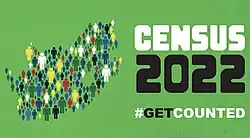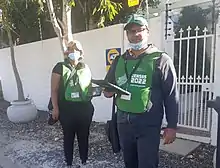| 4th National Census | ||
|---|---|---|
| ||
 | ||
| General information | ||
| Country | South Africa | |
| Results | ||
| Total population | 62 million (19.8% | |
| Most populous | Gauteng | |
| Least populous | Northern Cape | |

The South African National Census of 2022 is the 4th comprehensive census performed by Statistics South Africa (Stats SA).[1] The census results were released on 10 October 2023 and recorded a total of 62 million people in the country.[2][3]
Key findings
The first reports of statistics, published on 10 October 2023, showed a total population of 62,027,503.[4]
- Area: 1,220,813 square kilometres (471,359 sq mi)
- Population: 62,027,503
- Households: 17,828,778
Demographics
81,4% of the population is black African. The median age of the total population is 28 years.[4]
| Rank | Group | 2011 Census | 2022 Census | Change | Percent change |
|---|---|---|---|---|---|
| 1 |
Black African | 41,000,938 | 50,486,856 | 9,485,918 |
20.74% |
| 2 |
Coloured | 4,615,401 | 5,052,349 | 436,948 |
9.04% |
| 3 |
White | 4,586,838 | 4,504,252 | −82,586 |
-1.82% |
| 4 |
Asian or Indian | 1,286,930 | 1,697,506 | 410,576 |
27.51% |
| 5 |
Other | 280,454 | 247,353 | −33,101 |
-12.54% |
| Total population | 51,770,560 | 61,988,314 | 10,217,755 |
19,8% | |
| First language | WC | EC | NC | FS | KZN | NW | GP | MP | LP | SA |
|---|---|---|---|---|---|---|---|---|---|---|
| Afrikaans | 41.2 | 9.6 | 54.6 | 10.3 | 1 | 5.2 | 7.7 | 3.2 | 2.3 | 10.6% |
| English | 22 | 4.8 | 2.4 | 1.5 | 14.4 | 1 | 9.2 | 1.5 | 1 | 8.7% |
| IsiNdebele | 0.2 | 0.1 | 0 | 0.1 | 0 | 0.4 | 3.1 | 9.9 | 1.1 | 1.7% |
| IsiXhosa | 31.4 | 81.8 | 4.5 | 5.5 | 3.1 | 4.8 | 6.7 | 1 | 0.2 | 16.3% |
| IsiZulu | 0.4 | 0.3 | 0.3 | 3.7 | 80 | 1.6 | 23.1 | 27.8 | 0.6 | 24.4% |
| Sepedi | 0.1 | 0 | 0.1 | 0.2 | 0.1 | 2.1 | 12.6 | 10.3 | 55.5 | 10% |
| Sesotho | 1 | 2.4 | 1.2 | 72.3 | 0.6 | 5.9 | 13.1 | 2.3 | 0.8 | 7.8% |
| Setswana | 0.1 | 0 | 35.7 | 5.3 | 0 | 72.8 | 10.4 | 1.6 | 1.4 | 8.3% |
| SA Sign Language | 0.01 | 0.01 | 0.02 | 0.01 | 0.01 | 0.03 | 0.02 | 0.02 | 0.02 | 0.02% |
| SiSwati | 0 | 0 | 0 | 0.1 | 0 | 0.2 | 0.9 | 30.5 | 0.3 | 2.8% |
| Tshivenda | 0.1 | 0 | 0.1 | 0.1 | 0 | 0.4 | 2.4 | 0.2 | 17.4 | 2.5% |
| Xitsonga | 0.2 | 0.1 | 0.1 | 0.2 | 0 | 3.1 | 7 | 10.6 | 17.3 | 4.7% |
| Khoi, Nama & San languages | 0 | 0.01 | 0.17 | 0.01 | 0 | 0.01 | 0.01 | 0.01 | 0.01 | 0.01% |
| Shona | 2 | 0.5 | 0.4 | 0.3 | 0.3 | 1.6 | 2.1 | 0.6 | 1.6 | 1.2% |
| Chichewa, Nyanja | 0.5 | 0.1 | 0.1 | 0 | 0.2 | 0.2 | 0.6 | 0.1 | 0 | 0.3% |
| Portuguese | 0.1 | 0 | 0.1 | 0 | 0.1 | 0.2 | 0.3 | 0.3 | 0 | 0.2% |
| Other | 0.7 | 0.4 | 0.3 | 0.3 | 0.2 | 0.3 | 0.7 | 0.3 | 0.4 | 0.4% |
| Total | 100% | 100% | 100% | 100% | 100% | 100% | 100% | 100% | 100% | 100% |
| Rank | Gender | 2011 Census | 2022 Census | Change | Percent change |
|---|---|---|---|---|---|
| 1 |
Female | 26,581,769 | 31,948,746 | 5,366,977 |
18.33% |
| 2 |
Male | 25,188,791 | 30,078,757 | 4,889,966 |
17.69% |
| Rank | Province | 2011 Census | 2022 Census | Change | Percent
change |
|---|---|---|---|---|---|
| 1 |
Gauteng | 12,272,263 | 15,099,422 | 2,827,159 |
10.33% |
| 2 |
KwaZulu-Natal | 10,267,300 | 12,423,907 | 2,156,607 |
9.5% |
| 3 |
Western Cape | 5,822,734 | 7,433,019 | 1,610,285 |
12.15% |
| 4 |
Eastern Cape | 6,562,053 | 7,230,304 | 668,251 |
4.85% |
| 5 |
Limpopo | 5,404,868 | 6,572,720 | 1,167,852 |
9.75% |
| 6 |
Mpumalanga | 4,039,939 | 5,143,324 | 1,103,385 |
12.02% |
| 7 |
North West | 3,509,953 | 3,804,548 | 294,595 |
4.03% |
| 8 |
Free State | 2,745,590 | 2,964,412 | 218,822 |
3.83% |
| 9 |
Northern Cape | 1,145,861 | 1,355,946 | 210,085 |
8.4% |
| Total population | 51,770,560 | 62,027,602 | 10,257,041 |
9.01% | |
Collection issues
The census taking period was extended in the Western Cape province to 14 May 2022 after it was announced that only 58% of the province's population had participated in it by late April that year;[8] whilst around 80% of the country's whole population had been surveyed by the same date.[8] The deadline was extended a second time in the Western Cape to 31 May as only 78% of the province's population had been counted by the end of the first extension period.[9]
The issue of under-counting in the Western Cape Province was a serious issue of concern for the Western Cape Provincial government as it might result in fewer resources being allocated to the province by national government on a per-capita basis relative to the rest of the country.[8]
Stats SA reported particular difficulty in getting an accurate census count of both white and coloured residents which accounted for the low census participation rate in the Western Cape province.[10] In the Western Cape census workers reported difficulty in contacting households with high walls - thereby preventing many surveys from being conducted - whilst other households refused to participate in the census.[11] Other problems encountered by Stats SA in the province included not being able to hire enough census workers or being able to secure enough vehicles.[11]
After the publication of the census results it was reported that the undercount rate was 31%[12] with the undercount rate being the highest in the Western Cape.[6] The high undercount rate was reported as an issue of concern as it raised questions about the accuracy of the number of white, Indian, foreign-born and homeless people recorded in the census.[12]
See also
References
- ↑ "Registration for Census 2022 data collection is open | Statistics South Africa". Retrieved 17 December 2021.
- ↑ Mahlaka, Ray (10 October 2023). "Census 2022: SA population grows to 62 million". Daily Maverick. Retrieved 10 October 2023.
- ↑ Mitchley, Alex. "SA's population swells to 62 million - 2022 census at a glance". News24. Retrieved 10 October 2023.
- 1 2 "Statistician General Presentation" (PDF). Statssa.gov.za. Statistics South Africa. 10 October 2023.
- 1 2 "Census 2022: Statistical Release" (PDF). statssa.gov.za. 10 October 2023. p. 6. Retrieved 12 October 2023.
- 1 2 3 "Census 2022: Statistical Release" (PDF). statssa.gov.za. 10 October 2023. p. 9. Retrieved 12 October 2023.
- ↑ Census 2011: Statistical Release (PDF). Statistics South Africa. 2012. p. 14. Archived from the original (PDF) on 13 November 2015. Retrieved 24 November 2015.
- 1 2 3 Mafolo, Karabo (28 April 2022). "CENSUS 2022: Deadline extended to 14 May for Western Cape field workers after low provincial tally". Daily Maverick. Retrieved 5 May 2022.
- ↑ "New deadline for Western Cape census count after province misses the mark, again". CapeTalk. Retrieved 18 May 2022.
- ↑ Paton, Carol. "Low pay and racism in the Western Cape bogged down Census 2022, Stats SA says". Fin24. Retrieved 18 May 2022.
- 1 2 "Stats SA hit census snags in Western Cape". Ghanamma.com. 18 May 2022. Retrieved 18 May 2022.
- 1 2 Davis, Rebecca (12 October 2023). "How much can we rely on Census 2022?". Daily Maverick. Retrieved 13 October 2023.